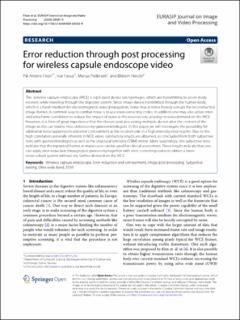| dc.contributor.author | Floor, Pål Anders | |
| dc.contributor.author | Farup, Ivar | |
| dc.contributor.author | Pedersen, Marius | |
| dc.contributor.author | Hovde, Øistein | |
| dc.date.accessioned | 2020-06-12T06:25:19Z | |
| dc.date.available | 2020-06-12T06:25:19Z | |
| dc.date.created | 2020-06-08T11:14:16Z | |
| dc.date.issued | 2020 | |
| dc.identifier.citation | EURASIP Journal on Image and Video Processing. 2020, 14 | en_US |
| dc.identifier.issn | 1687-5176 | |
| dc.identifier.uri | https://hdl.handle.net/11250/2657796 | |
| dc.description.abstract | The wireless capsule endoscope (WCE) is a pill-sized device taking images, which are transmitting to an on-body receiver, while traveling through the digestive system. Since image data is transmitted through the human body, which is a harsh medium for electromagnetic wave propagation, noise may at times heavily corrupt the reconstructed image frames. A common way to combat noise is to use error-correcting codes. In addition one may also utilize inter- and intra frame correlation to reduce the impact of noise at the receiver side, placing no extra demand on the WCE. However, it is then of great importance that the chosen post processing methods do not alter the content of the image as this can lead to miss-detection by gastroenterologists. In this paper we will investigate the possibility for additional noise suppression and error concealment at the receiver side in a high intensity error regime. Due to the high correlation generally inherent in WCE video, satisfactory results are obtained, as concluded from both subjective tests with gastroenterologists as well as the structural similarity (SSIM) metric. More surprisingly, the subjective tests indicate that the inpainted frames in many cases can be used for clinical assessment. These results indicate that one can apply error reduction through post processing together with error-correcting codes to obtain a more noise-robust system without any further demand on the WCE. | en_US |
| dc.language.iso | eng | en_US |
| dc.publisher | Springer Nature | en_US |
| dc.rights | Navngivelse 4.0 Internasjonal | * |
| dc.rights.uri | http://creativecommons.org/licenses/by/4.0/deed.no | * |
| dc.title | Error reduction through post processing for wireless capsule endoscope video | en_US |
| dc.type | Peer reviewed | en_US |
| dc.type | Journal article | en_US |
| dc.description.version | publishedVersion | en_US |
| dc.source.journal | EURASIP Journal on Image and Video Processing | en_US |
| dc.source.issue | 14 | en_US |
| dc.identifier.doi | https://doi.org/10.1186/s13640-020-00503-9 | |
| dc.identifier.cristin | 1814283 | |
| dc.relation.project | Norges forskningsråd: 300031 | en_US |
| dc.relation.project | Norges forskningsråd: 247689 | en_US |
| dc.description.localcode | Open Access This article is licensed under a Creative Commons Attribution 4.0 International License, which permits use, sharing, adaptation, distribution and reproduction in any medium or format, as long as you give appropriate credit to the original author(s) and the source, provide a link to the Creative Commons licence, and indicate if changes were made. The images or other third party material in this article are included in the article’s Creative Commons licence, unless indicated otherwise in a credit line to the material. If material is not included in the article’s Creative Commons licence and your intended use is not permitted by statutory regulation or exceeds the permitted use, you will need to obtain permission directly from the copyright holder. To view a copy of this licence, visit http://creativecommons.org/licenses/by/4.0/. | en_US |
| cristin.ispublished | true | |
| cristin.fulltext | original | |
| cristin.qualitycode | 1 | |

